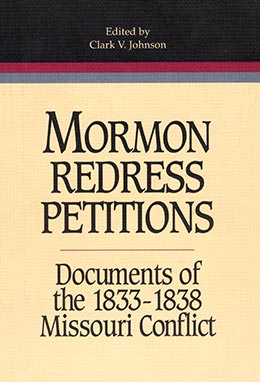Introduction to Part III
Introduction to Part III in Mormon Redress Petitions: Documents of the 1833–1838 Missouri Conflict, ed. Clark V. Johnson (Provo, Utah: Religious Studies Center, Brigham Young University, 1992), 393.
In October of 1840, after the unsuccessful first appeal, Church members sustained the Prophet Joseph Smith’s proposal that “Elias Higbee and Robert B. Thompson be appointed a committee to obtain redress for the wrongs sustained in Missouri” (HC 4:206; JH 5 Oct 1840). Higbee and Thompson drafted a memorial whose substance was much like the first memorial prepared in 1839 by the Prophet, Sidney Rigdon, and Higbee (HC 4:237), and on 21 December 1840 this petition, possibly accompanied by some individual claims, was “presented to the House of Representatives . . . referred to the committee of the Judiciary and ordered to be printed” (HC 4:250–51; JH 21 Dec 1840). Apparently the petition was printed and circulated within Congress because Mr. Linn of Missouri asked that the legal proceedings held in Missouri also be printed that his state’s character might not be impugned (Congressional Globe 9:175).
The present location of the Higbee-Thompson memorial is not known. Any individual peitions that may have accompanied it might have been intermixed with the next appeal in the National Archives, for in 1842 Higbee, John Taylor, and Elias Smith wrote another memorial probably to introduce more individual petitions. This final memorial is almost identical to the first memorial and is housed in the National Archives.
For organizational purposes, we have called Part III, which includes all of the individual petitions from the National Archives, most of which are dated 1840, the “Second Appeal.” It is not known how or when these individual petitions were sent to Washington. They may have been sent with the Higbee-Thompson memorial in late 1840, they may have been sent with the final memorial in 1842, or some may have been sent with each.
Illinois Representatives John T. Stuart and John D. Reynolds, and Illinois Senator Richard M. Young helped to present the Mormon cause in Congress (Bateman and Selby 446). These attempts failed and the petitions of this second appeal, along with the last memorial, were sent to the National Archives, where they remained until they were discovered in the late 1960s or early 1970s.
Perhaps the petitions were not left in Washington through oversight or neglect but to keep the matter before Congress. It appears that these petitions formed the basis for subsequent efforts made by Orson Pratt, Orson Hyde, Jesse C. Little and others to place the Mormon cause before the members and the President.
